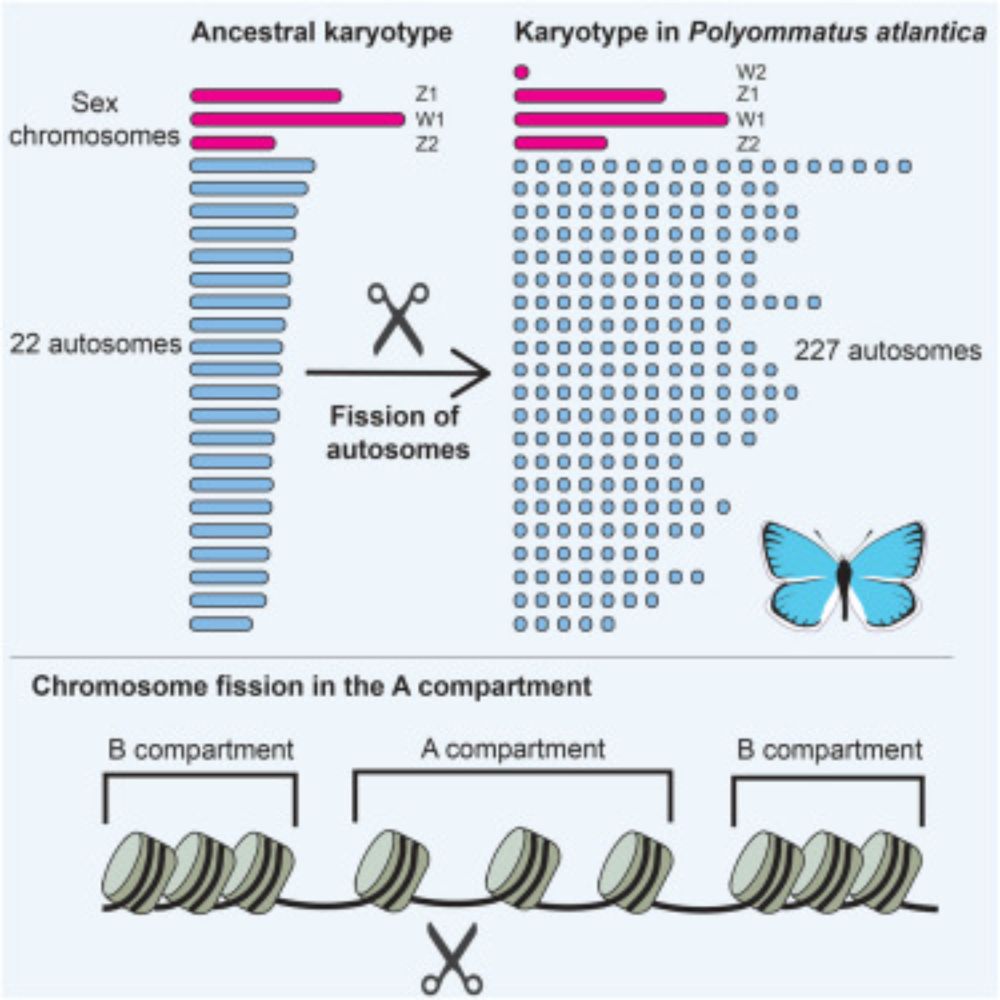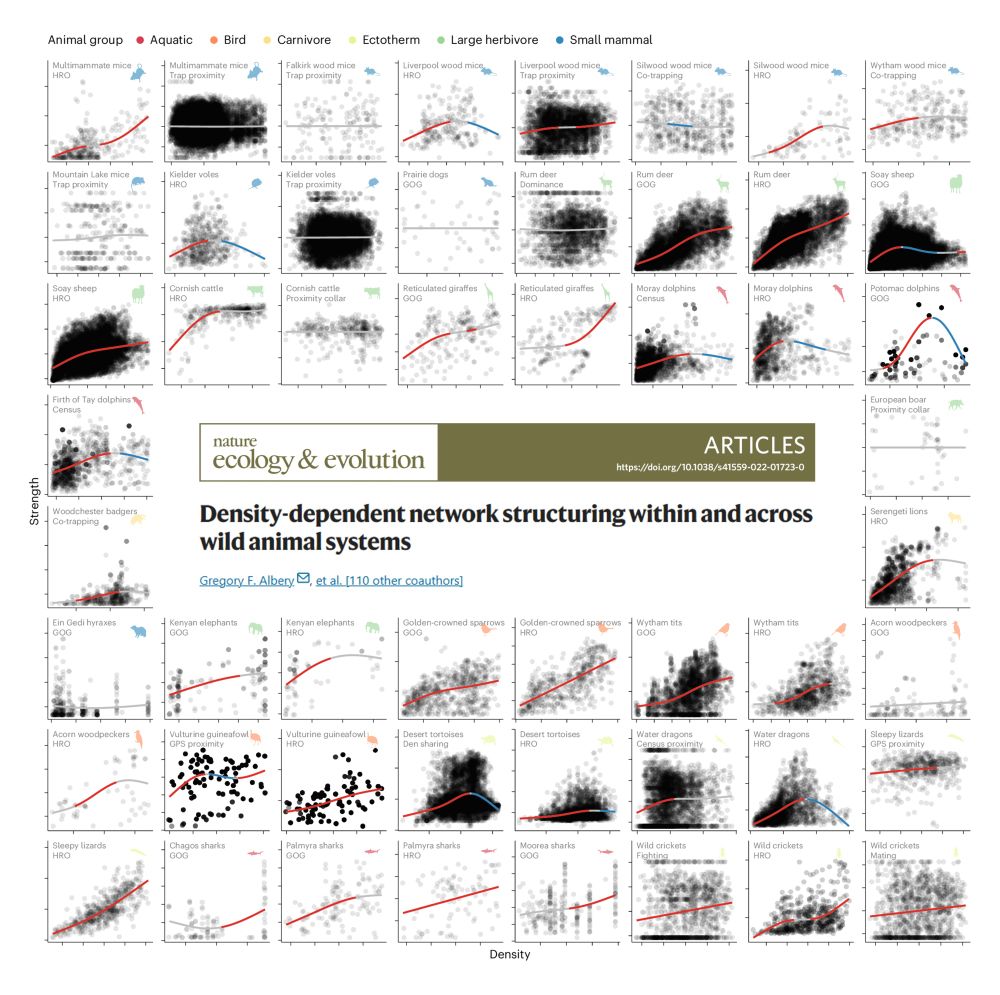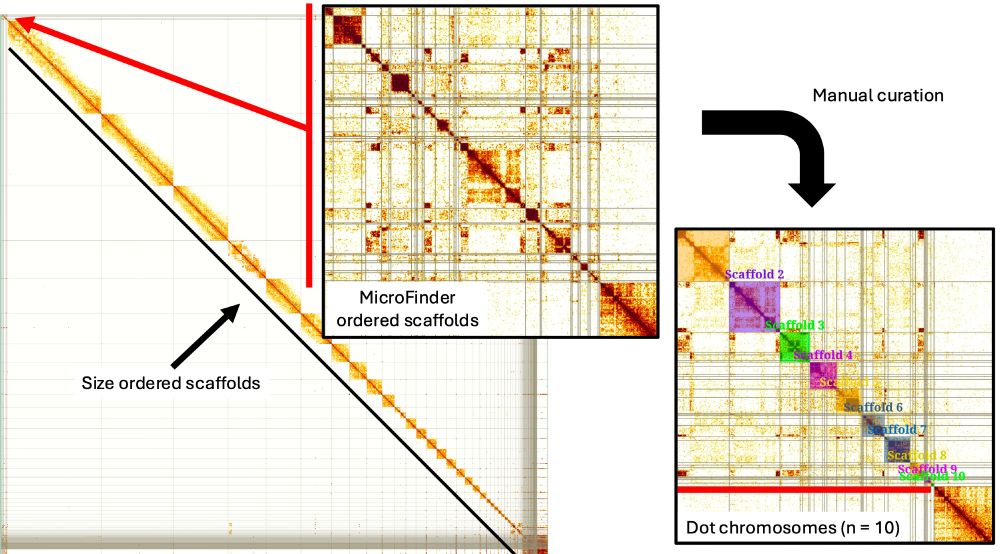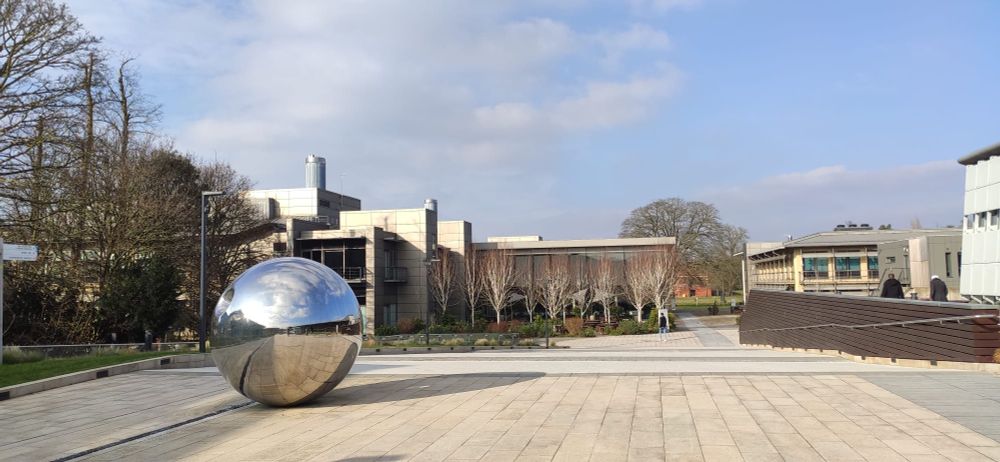
Lewis Stevens
@phylewgenetics.bsky.social
I like worms, genomes, & evolution.
Postdoc in Tree of Life @ Wellcome Sanger Institute. He/him.
Postdoc in Tree of Life @ Wellcome Sanger Institute. He/him.
Reposted by Lewis Stevens
I'm v excited to be recruiting a PhD student to work on badger behaviour and ecology! Starting date is March 2026; see the ad here, or message me for more details: www.gregalbery.me/s/March-2026...

October 3, 2025 at 2:05 PM
I'm v excited to be recruiting a PhD student to work on badger behaviour and ecology! Starting date is March 2026; see the ad here, or message me for more details: www.gregalbery.me/s/March-2026...
New preprint! We unexpectedly discovered that some Caenorhabditis species delete parts of their somatic genome early in development, which fragments their chromosomes and eliminates key germline genes. Multiple lines of evidence suggest this bizarre process was present in the ancestors of C. elegans

October 28, 2025 at 12:11 PM
New preprint! We unexpectedly discovered that some Caenorhabditis species delete parts of their somatic genome early in development, which fragments their chromosomes and eliminates key germline genes. Multiple lines of evidence suggest this bizarre process was present in the ancestors of C. elegans
Reposted by Lewis Stevens
Programmed DNA elimination was present in the last common ancestor of Caenorhabditis nematodes https://www.biorxiv.org/content/10.1101/2025.10.23.681605v1
October 24, 2025 at 9:32 PM
Programmed DNA elimination was present in the last common ancestor of Caenorhabditis nematodes https://www.biorxiv.org/content/10.1101/2025.10.23.681605v1
Reposted by Lewis Stevens
Programmed DNA elimination was present in the last common ancestor of Caenorhabditis nematodes https://www.biorxiv.org/content/10.1101/2025.10.23.681605v1
October 24, 2025 at 9:32 PM
Programmed DNA elimination was present in the last common ancestor of Caenorhabditis nematodes https://www.biorxiv.org/content/10.1101/2025.10.23.681605v1
Reposted by Lewis Stevens
Really, really happy that our work on microsporidian genomes is now out in @plosbiology.org! A huge thank you to my coauthors, my supervisors @mblaxter.bsky.social & @marakat.bsky.social, the editors @roliroberts.bsky.social & Joseph Heitman, and the reviewers ❤️ plos.io/48HsAQJ
October 22, 2025 at 10:47 AM
Really, really happy that our work on microsporidian genomes is now out in @plosbiology.org! A huge thank you to my coauthors, my supervisors @mblaxter.bsky.social & @marakat.bsky.social, the editors @roliroberts.bsky.social & Joseph Heitman, and the reviewers ❤️ plos.io/48HsAQJ
Reposted by Lewis Stevens
And look at this graphic abstract….. 😱🤯

October 5, 2025 at 2:00 AM
And look at this graphic abstract….. 😱🤯
Reposted by Lewis Stevens
Which journal would publish such a fragmented mess?
www.cell.com/current-biol...
www.cell.com/current-biol...
October 8, 2025 at 11:48 AM
Which journal would publish such a fragmented mess?
www.cell.com/current-biol...
www.cell.com/current-biol...
Reposted by Lewis Stevens
Preprint Alert! 🦥
We produced complete genomes for 2 Xenarthra and placed them in a mammalian comparative framework. We found that Xenarthra harbour the largest number of retrocopies in mammals! www.biorxiv.org/content/10.1...
We produced complete genomes for 2 Xenarthra and placed them in a mammalian comparative framework. We found that Xenarthra harbour the largest number of retrocopies in mammals! www.biorxiv.org/content/10.1...

Retrocopy formation and domestication shape genome evolution in sloths and other xenarthrans
Xenarthrans, comprising sloths, anteaters, and armadillos, represent one of the most morphologically and physiologically specialised mammalian clades, yet the genomic basis of their adaptations remain...
www.biorxiv.org
October 2, 2025 at 9:16 PM
Preprint Alert! 🦥
We produced complete genomes for 2 Xenarthra and placed them in a mammalian comparative framework. We found that Xenarthra harbour the largest number of retrocopies in mammals! www.biorxiv.org/content/10.1...
We produced complete genomes for 2 Xenarthra and placed them in a mammalian comparative framework. We found that Xenarthra harbour the largest number of retrocopies in mammals! www.biorxiv.org/content/10.1...
Reposted by Lewis Stevens
How many chromosomes can an animal have?
In our paper out now in @currentbiology.bsky.social we show that the Atlas blue butterfly has 229 chromosome pairs- the highest in diploid Metazoa! These arose by rapid autosome fragmentation while sex chromosomes stayed intact.
www.cell.com/current-biol...
In our paper out now in @currentbiology.bsky.social we show that the Atlas blue butterfly has 229 chromosome pairs- the highest in diploid Metazoa! These arose by rapid autosome fragmentation while sex chromosomes stayed intact.
www.cell.com/current-biol...

Constraints on chromosome evolution revealed by the 229 chromosome pairs of the Atlas blue butterfly
The genome of the Atlas blue butterfly contains ten times more chromosomes than most
butterflies, and more than any other known diploid animal. Wright et al. show that
this extraordinary karyotype is ...
tinyurl.com
September 11, 2025 at 3:22 PM
How many chromosomes can an animal have?
In our paper out now in @currentbiology.bsky.social we show that the Atlas blue butterfly has 229 chromosome pairs- the highest in diploid Metazoa! These arose by rapid autosome fragmentation while sex chromosomes stayed intact.
www.cell.com/current-biol...
In our paper out now in @currentbiology.bsky.social we show that the Atlas blue butterfly has 229 chromosome pairs- the highest in diploid Metazoa! These arose by rapid autosome fragmentation while sex chromosomes stayed intact.
www.cell.com/current-biol...
Reposted by Lewis Stevens
That is, Oceania looks like a source for Asian species, not the reverse! Here’s the preprint.

Caenorhabditis diversity on Pohnpei, Micronesia, provides evidence that the Elegans Supergroup has its roots in the Americas and diversified in the Pacific en route to Asia
The microscopic nematode Caenorhabditis elegans stands unrivaled as a model for developmental biology, neurobiology, and genetics, but fundamental aspects of its ecology, biogeography, and natural his...
www.biorxiv.org
September 24, 2025 at 8:33 PM
That is, Oceania looks like a source for Asian species, not the reverse! Here’s the preprint.
Reposted by Lewis Stevens
C. elegans is a real animal and we set out to understand how it comes to have its distinctive biogeography. Its ancestral center of diversity is in the higher elevation forests of Hawaii. Its closest relatives are spread across east Asia. Did they travel from Asia? [Preprint 🧵]
September 24, 2025 at 8:33 PM
C. elegans is a real animal and we set out to understand how it comes to have its distinctive biogeography. Its ancestral center of diversity is in the higher elevation forests of Hawaii. Its closest relatives are spread across east Asia. Did they travel from Asia? [Preprint 🧵]
Reposted by Lewis Stevens
Celebrating the publication of our big collaborative spatial-social meta-analysis of density-dependent transmission effects, out now in Nature Eco Evo! doi.org/10.1038/s415... (or rdcu.be/eD6eB)

September 8, 2025 at 2:53 PM
Celebrating the publication of our big collaborative spatial-social meta-analysis of density-dependent transmission effects, out now in Nature Eco Evo! doi.org/10.1038/s415... (or rdcu.be/eD6eB)
Reposted by Lewis Stevens
New preprint! We generate 40 new high-quality microsporidian genomes from infected arthropod hosts that were sequenced to create reference genomes by the Darwin Tree of Life project. 8 of our genomes are chromosome-level, and we’re able to generate Hi-C data for 7! 🧬
www.biorxiv.org/content/10.1...
www.biorxiv.org/content/10.1...

Forty New Genomes Shed Light on Sexual Reproduction and the Origin of Tetraploidy in Microsporidia
Microsporidia are single-celled, obligately intracellular parasites with growing public health, agricultural, and economic importance. Despite this, Microsporidia remain relatively enigmatic, with man...
www.biorxiv.org
May 16, 2025 at 10:58 AM
New preprint! We generate 40 new high-quality microsporidian genomes from infected arthropod hosts that were sequenced to create reference genomes by the Darwin Tree of Life project. 8 of our genomes are chromosome-level, and we’re able to generate Hi-C data for 7! 🧬
www.biorxiv.org/content/10.1...
www.biorxiv.org/content/10.1...
Reposted by Lewis Stevens
Struggling to find the tiny microchromosomes in draft bird genome assemblies?
Our new #preprint introducing MicroFinder can help: www.biorxiv.org/content/10.1...
🧵 below
(1/n)
@sangerinstitute.bsky.social
Our new #preprint introducing MicroFinder can help: www.biorxiv.org/content/10.1...
🧵 below
(1/n)
@sangerinstitute.bsky.social

May 16, 2025 at 10:07 AM
Struggling to find the tiny microchromosomes in draft bird genome assemblies?
Our new #preprint introducing MicroFinder can help: www.biorxiv.org/content/10.1...
🧵 below
(1/n)
@sangerinstitute.bsky.social
Our new #preprint introducing MicroFinder can help: www.biorxiv.org/content/10.1...
🧵 below
(1/n)
@sangerinstitute.bsky.social
Reposted by Lewis Stevens
Delighted to have been awarded a BBSRC Fellowship to look at the genetics of how insects have adapted to living in freshwater habitats 🧬🦋🪰🪲🌊
Extremely grateful to all who have supported me over the years and excited to be at Liverpool with some great colleagues!
www.ukri.org/news/9-milli...
Extremely grateful to all who have supported me over the years and excited to be at Liverpool with some great colleagues!
www.ukri.org/news/9-milli...

£9 million investment fuels groundbreaking bioscience research
From unlocking the secrets of animal movement to tackling antimicrobial resistance, UK’s brightest bioscience minds are pushing the boundaries of innovation.
www.ukri.org
April 22, 2025 at 3:57 PM
Delighted to have been awarded a BBSRC Fellowship to look at the genetics of how insects have adapted to living in freshwater habitats 🧬🦋🪰🪲🌊
Extremely grateful to all who have supported me over the years and excited to be at Liverpool with some great colleagues!
www.ukri.org/news/9-milli...
Extremely grateful to all who have supported me over the years and excited to be at Liverpool with some great colleagues!
www.ukri.org/news/9-milli...
Reposted by Lewis Stevens
A non-vesicular Argonaute protein is transmitted from nematode to mouse and is important for parasite survival https://www.biorxiv.org/content/10.1101/2025.04.01.646544v1
April 2, 2025 at 3:18 AM
A non-vesicular Argonaute protein is transmitted from nematode to mouse and is important for parasite survival https://www.biorxiv.org/content/10.1101/2025.04.01.646544v1
Reposted by Lewis Stevens
Very excited to share this collaborative work led by Kyriaki Neophytou. An extracellular Argonaute from a nematode parasite is transmitted to host cells and the non-vesicular form is functionally important (and now a vaccine candidate). An Argonaute vaccine... who would have thought.
A non-vesicular Argonaute protein is transmitted from nematode to mouse and is important for parasite survival https://www.biorxiv.org/content/10.1101/2025.04.01.646544v1
April 2, 2025 at 6:13 AM
Very excited to share this collaborative work led by Kyriaki Neophytou. An extracellular Argonaute from a nematode parasite is transmitted to host cells and the non-vesicular form is functionally important (and now a vaccine candidate). An Argonaute vaccine... who would have thought.
Reposted by Lewis Stevens
Super excited to see our work shared with the scientific community! We know #Argonaute proteins can be extracellular, but can they be transferred to recipient cells and can they function? Happy reading!
A non-vesicular Argonaute protein is transmitted from nematode to mouse and is important for parasite survival https://www.biorxiv.org/content/10.1101/2025.04.01.646544v1
April 2, 2025 at 11:05 AM
Super excited to see our work shared with the scientific community! We know #Argonaute proteins can be extracellular, but can they be transferred to recipient cells and can they function? Happy reading!
Reposted by Lewis Stevens
Our paper on myxozoan genomes is out now in G3! See thread below for a brief recap (slight change of title from the preprint, same content).
Thank you also to @arunsethuraman.bsky.social for handling the manuscript and @joannamasel.bsky.social for helpful comments.
academic.oup.com/g3journal/ad...
Thank you also to @arunsethuraman.bsky.social for handling the manuscript and @joannamasel.bsky.social for helpful comments.
academic.oup.com/g3journal/ad...
March 21, 2025 at 11:15 AM
Our paper on myxozoan genomes is out now in G3! See thread below for a brief recap (slight change of title from the preprint, same content).
Thank you also to @arunsethuraman.bsky.social for handling the manuscript and @joannamasel.bsky.social for helpful comments.
academic.oup.com/g3journal/ad...
Thank you also to @arunsethuraman.bsky.social for handling the manuscript and @joannamasel.bsky.social for helpful comments.
academic.oup.com/g3journal/ad...
Reposted by Lewis Stevens
This is an absolutely insane story! Autosomes shattered to pieces 🫠 while sex chromosomes entirely intact 😎. Wicked evolution of atlas blues 🦋 by @charlottewright.bsky.social et al. @sangerinstitute.bsky.social
The 229 chromosomes of the Atlas blue butterfly reveal rules constraining chromosome evolution in Lepidoptera https://www.biorxiv.org/content/10.1101/2025.03.14.642909v1
March 20, 2025 at 8:34 PM
This is an absolutely insane story! Autosomes shattered to pieces 🫠 while sex chromosomes entirely intact 😎. Wicked evolution of atlas blues 🦋 by @charlottewright.bsky.social et al. @sangerinstitute.bsky.social
Reposted by Lewis Stevens
(1/4) In its first year, #ProjectPsyche has engaged with the research community by creating networks with experts in moths and butterflies 🦋 Members of the project have also trained the research community in #GenomeCuration, a key step in the generation of genomes 🧬

March 20, 2025 at 7:43 AM
(1/4) In its first year, #ProjectPsyche has engaged with the research community by creating networks with experts in moths and butterflies 🦋 Members of the project have also trained the research community in #GenomeCuration, a key step in the generation of genomes 🧬
Reposted by Lewis Stevens
The 229 chromosomes of the Atlas blue butterfly reveal rules constraining chromosome evolution in Lepidoptera https://www.biorxiv.org/content/10.1101/2025.03.14.642909v1
March 17, 2025 at 7:32 PM
The 229 chromosomes of the Atlas blue butterfly reveal rules constraining chromosome evolution in Lepidoptera https://www.biorxiv.org/content/10.1101/2025.03.14.642909v1
Reposted by Lewis Stevens
Evolution of developmental bias explains divergent patterns of phenotypic evolution https://www.biorxiv.org/content/10.1101/2025.02.04.636455v1
February 5, 2025 at 10:34 AM
Evolution of developmental bias explains divergent patterns of phenotypic evolution https://www.biorxiv.org/content/10.1101/2025.02.04.636455v1
Reposted by Lewis Stevens
Two postdoctoral positions at the Wellcome Sanger Institute focus on symbiosis genomics, analyzing eukaryotic and prokaryotic cobionts. Closing date: Jan 26, … https://sanger.wd103.myworkdayjobs.com/en-US/WellcomeSangerInstitute/details/Postdoctoral-Fellow--Microbiomes-of-Tree-of-Life-_JR102528 #job

Postdoctoral Fellow (Microbiomes of Tree of Life)
Do you want to help us improve human health and understand life on Earth? Make your mark by shaping the future to enable or deliver life-changing science to solve some of humanity’s greatest challenges. We have an exciting opportunity for a Postdoctoral Fellow to work with Tree of Life and Parasites and Microbes teams to identify cobionts in genome sequence datasets as they are generated and thus build a catalogue of host-microbe associations. This PDF contract will be 3 years fixed term at the Sanger Institute Life on planet Earth is a complex web of interactions between organisms, some mutualistic, some harmful, some neutral. While sequencing diverse eukaryotic species, the Tree of Life programme at the Sanger Institute is also able to assemble the genomes of many (often unexpected) bacterial, archaeal and eukaryotic microbial organisms. We already have assemblies for over 6,000 bacterial, archaeal and eukaryotic microbes. These “cobionts” represent a subsampling of the organisms associated with the target species, and may be pathogens, parasites, components of the microbiome or chance encounters. To understand these cobionts more fully, we are seeking a Postdoctoral Fellow to work in a collaboration between the Tree of Life (ToL) and the Parasites and Microbes (PaM) programmes to collate, annotate and explore the biology of the bacterial and archaeal cobionts we discover. About the Role: You will work with ToL and PaM teams to identify cobionts in genome sequence datasets as they are generated and thus build a catalogue of host-microbe associations. You will explore the evolutionary and systems biology of host-microbiome interactions, including identification of phylogenetic associations between hosts and microbes, exploration of virulence and other phenotypes in pathogens, exploration of phage metagenomes, definition and functional analysis of horizontal DNA transfers into host genomes, and other topics. Where required, additional data will be commissioned to better evidence particular aspects of host and microbe. About Us: The post is shared between the Blaxter group (which has a focus on large scale analysis of genome evolution across diversity) and groups within PaM who have interests in (respectively) the genomic epidemiology of human pathogens and human microbiomes in health and disease. You will be embedded in a supportive and dynamic environment to produce significant work of wide impact. About You: You should have a PhD in Biomedical science, statistical genetics, microbial genomics, computational biology or similar related discipline or equivalent working experience in bioinformatics. You will have the ability to analyse and interpret data with strong quantitative/computational skills. You will have relevant programming skills in modern languages including Python and R and experience with software development and good practice in coding. Applicants should have excellent communication and organisational skills, and have the ability to work collaboratively with a range of stakeholders. When you join us as a Postdoctoral Fellow, you will benefit from a unique and well-resourced learning environment that will equip you for your future career. We are proud to produce and analyse genetic and cellular data on a scale unmatched by other institutes in Europe to advance biological and medical science. Essential Scientific and Technical Skills: PhD in relevant subject area, or on track to be awarded your PhD within 6 months of starting the role Proven ability to deliver research projects A track record of demonstrating research excellence and expertise in your area of research Knowledge, skills and experience as appropriate to the research area including: Ability to analyse and interpret data with strong quantitative/computational skills Programming in relevant, modern languages, including Python and R; experience with software development and good practice in coding Excellent communication and organisation skills Ability to work collaboratively and inclusively with a range of stakeholders Essential Competencies and Behavioural Skills: Proven ability to develop and maintain effective working relationships with wide range of persons of differing level, abilities and knowledge Foster an inclusive culture where all can thrive and diversity is celebrated Team player with the ability to work with others in a collegiate and collaborative environment Ability to effectively communicate ideas and results and present orally to groups Commitment to personal development and updating of knowledge and skills Ability to prioritise, multi-task and work independently Detail-orientated, with strong organisational and problem-solving skills Other information Please apply with your CV and a Cover Letter outlining how you would meet the criteria set out above. Salary: PDF £38,000 - £49,156 Role profile Closing Date: 26th January 2025 Recruitment Process: Zoom interviews w/c 3rd Feb, Face to face Interviews w/c 10th Feb Contract Type: 3 years fixed term contract Hybrid Working at Wellcome Sanger: We recognise that there are many benefits to Hybrid Working; including an improved work-life balance, with more focused time, as well as the ability to organise working time so that collaborative opportunities and team discussions are facilitated on campus. The hybrid working arrangement will vary for different roles and teams. The nature of your role and the type of work you do will determine if a hybrid working arrangement is possible. Equality, Diversity and Inclusion: We aim to attract, recruit, retain and develop talent from the widest possible talent pool, thereby gaining insight and access to different markets to generate a greater impact on the world. We have a supportive culture with the following staff networks, LGBTQ+, Parents and Carers, Disability and Race Equity to bring people together to share experiences, offer specific support and development opportunities and raise awareness. The networks are also a place for allies to provide support to others. We want our people to be whoever they want to be because we believe people who bring their best selves to work, do their best work. That’s why we’re committed to creating a truly inclusive culture at Sanger Institute. We will consider all individuals without discrimination and are committed to creating an inclusive environment for all employees, where everyone can thrive. Our Benefits: We are proud to deliver an awarding campus-wide employee wellbeing strategy and programme. The importance of good health and adopting a healthier lifestyle and the commitment to reduce work-related stress is strongly acknowledged and recognised at Sanger Institute. Sanger Institute became a signatory of the International Technician Commitment initiative In March 2018. The Technician Commitment aims to empower and ensure visibility, recognition, career development and sustainability for technicians working in higher education and research, across all disciplines. Life at the Sanger Institute is unique. We are tackling some of the most difficult challenges in genomic research. Our people are shaping the future by delivering life-changing science with the reach, scale, and creativity to solve some of humanity’s greatest challenges. We aim to attract, recruit, retain and develop talent from the widest possible talent pool, thereby gaining insight and access to different markets to generate a greater impact on the world.
sanger.wd103.myworkdayjobs.com
January 7, 2025 at 7:13 AM
Two postdoctoral positions at the Wellcome Sanger Institute focus on symbiosis genomics, analyzing eukaryotic and prokaryotic cobionts. Closing date: Jan 26, … https://sanger.wd103.myworkdayjobs.com/en-US/WellcomeSangerInstitute/details/Postdoctoral-Fellow--Microbiomes-of-Tree-of-Life-_JR102528 #job
Reposted by Lewis Stevens
Most of my time this year has been working on this new dengue nomenclature system with a huge and brilliant set of global collaborators!! Glad to see other people think it's worthwhile too 😎 @nathangrubaugh.bsky.social
As front section editor, @droutledge.bsky.social himself chose this "consensus view" of dengue virus nomenclature by @viralverity.bsky.social @nathangrubaugh.bsky.social and many others: journals.plos.org/plosbiology/...

A new lineage nomenclature to aid genomic surveillance of dengue virus
Dengue virus (DENV) is causing increasingly larger and more widespread epidemics, which makes it critical to track the virus using genomic surveillance, but there is currently no suitable system to cl...
journals.plos.org
January 3, 2025 at 1:54 PM
Most of my time this year has been working on this new dengue nomenclature system with a huge and brilliant set of global collaborators!! Glad to see other people think it's worthwhile too 😎 @nathangrubaugh.bsky.social

